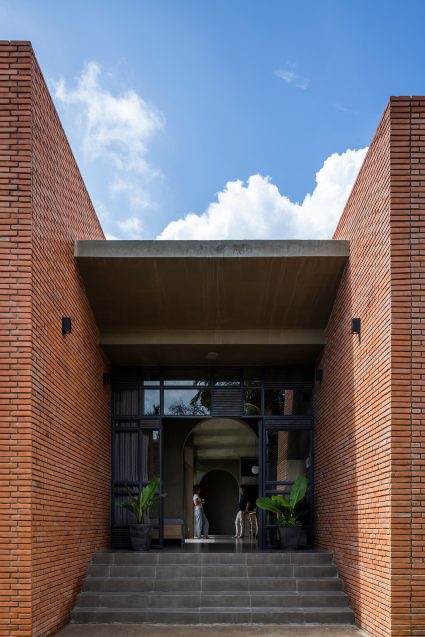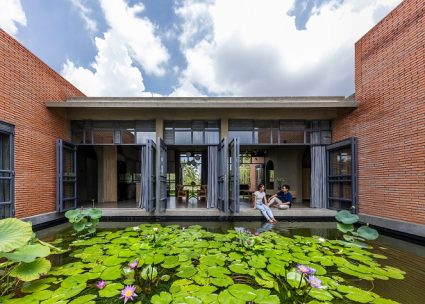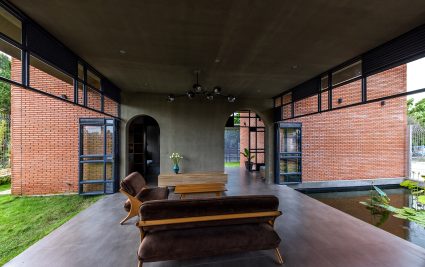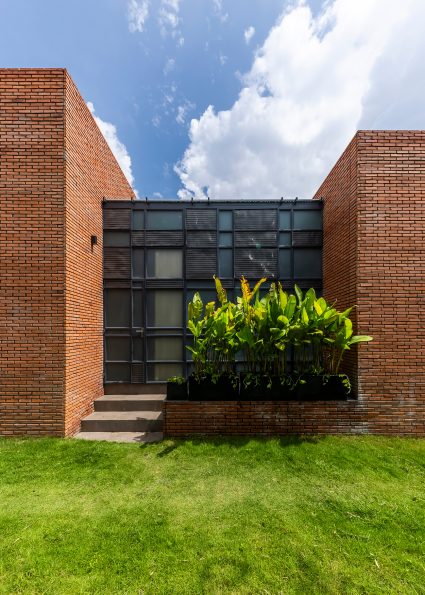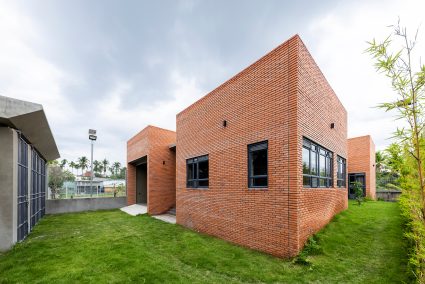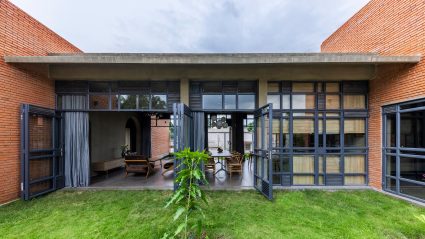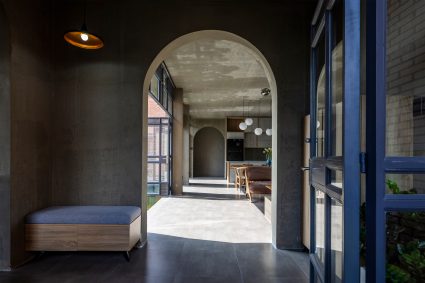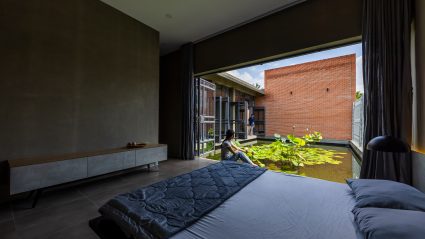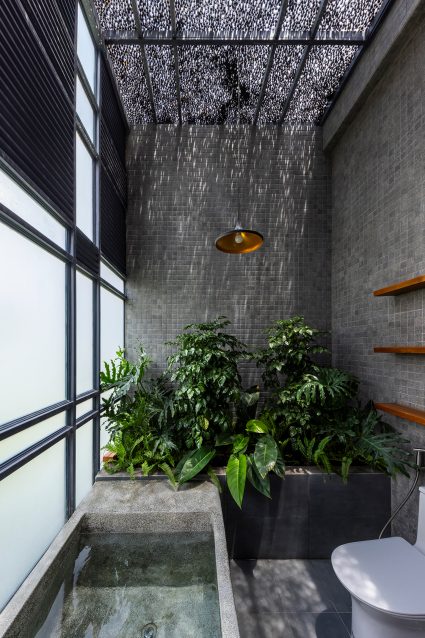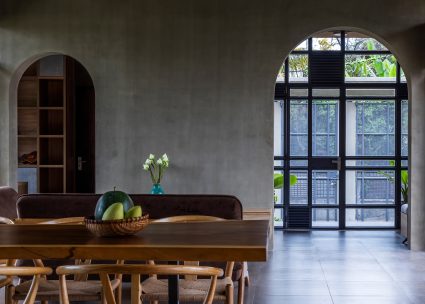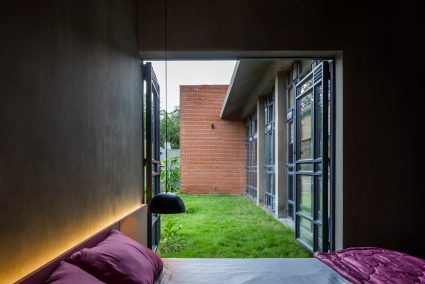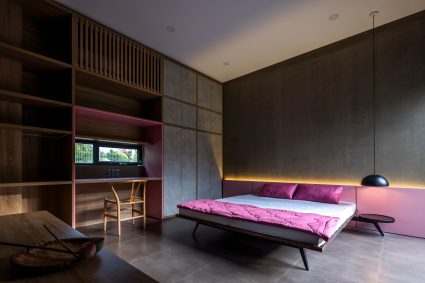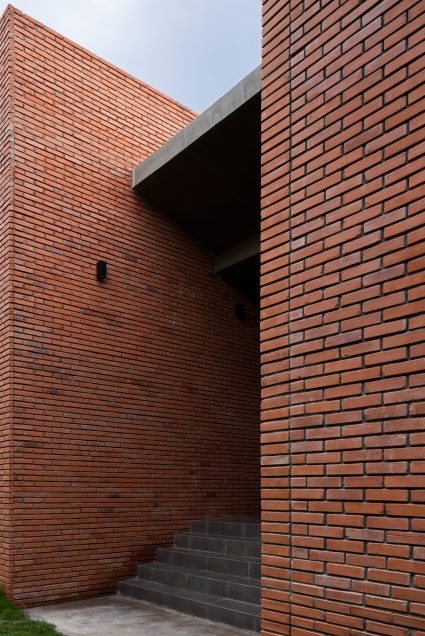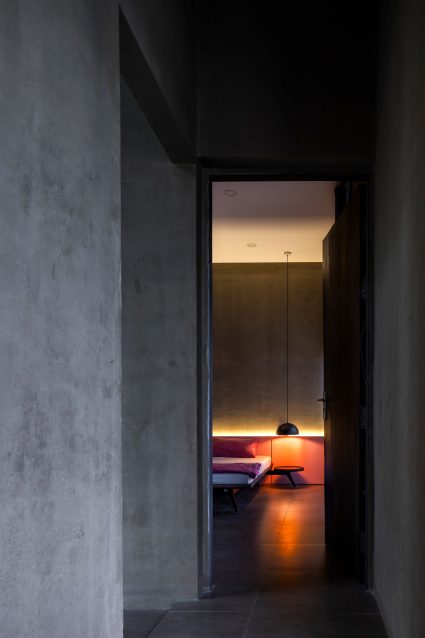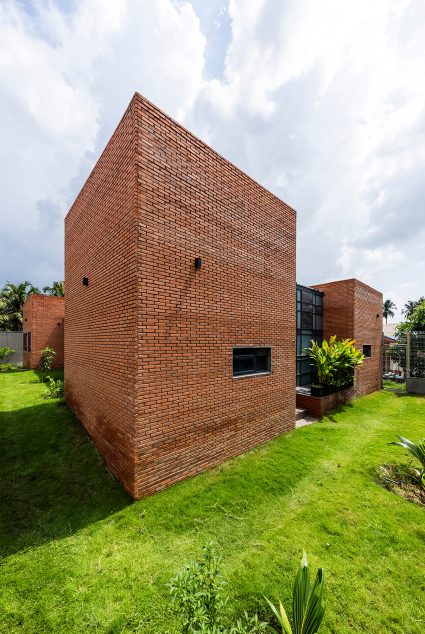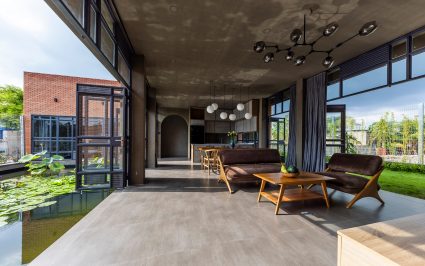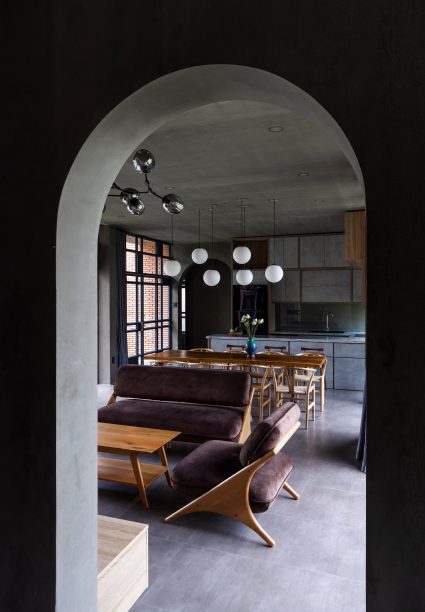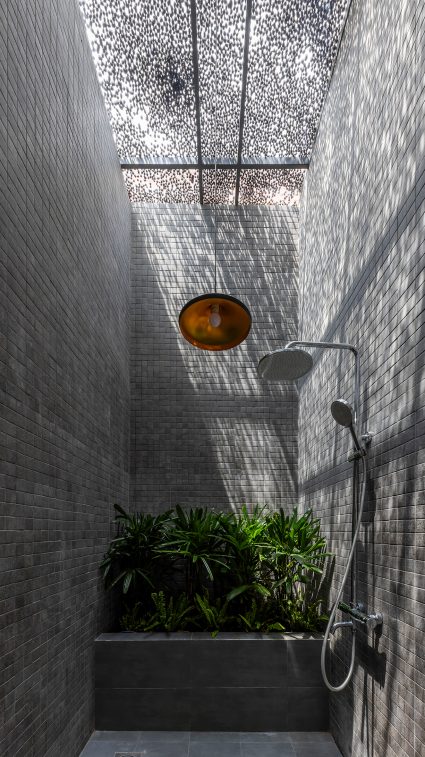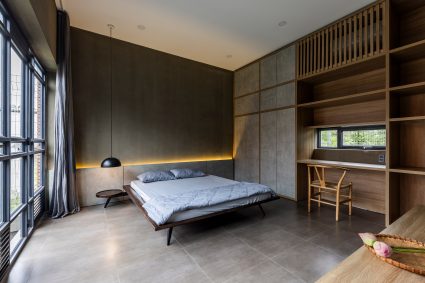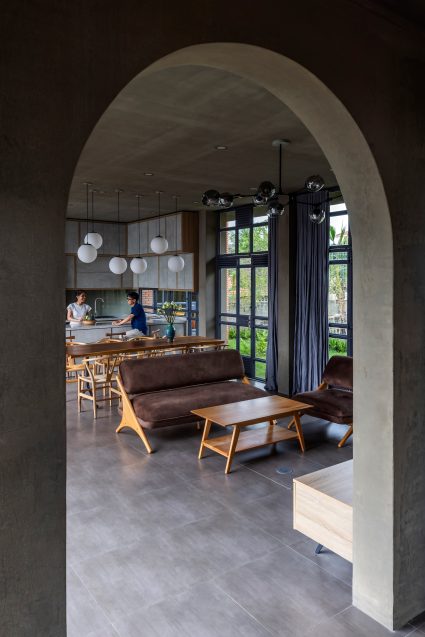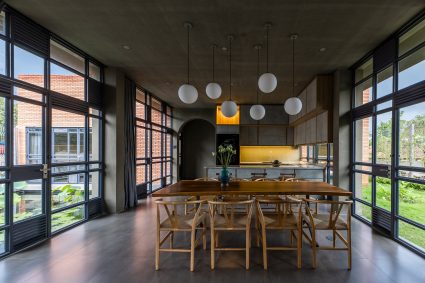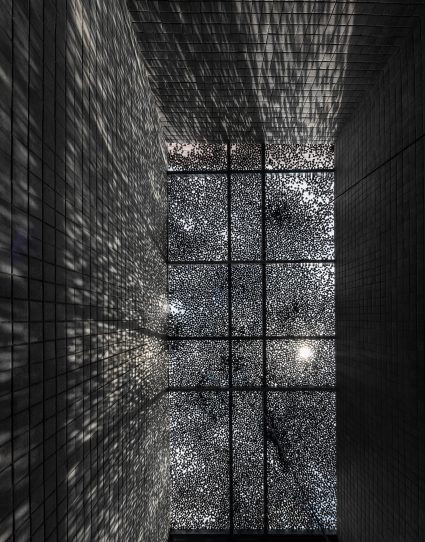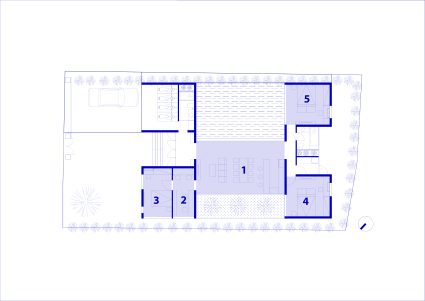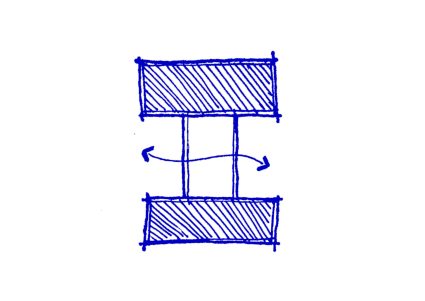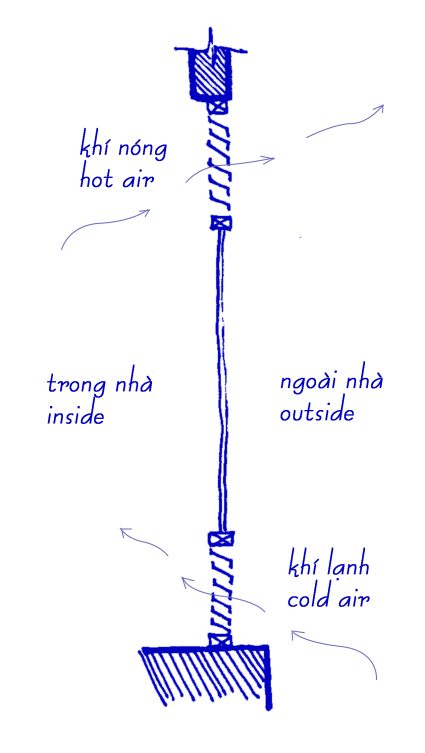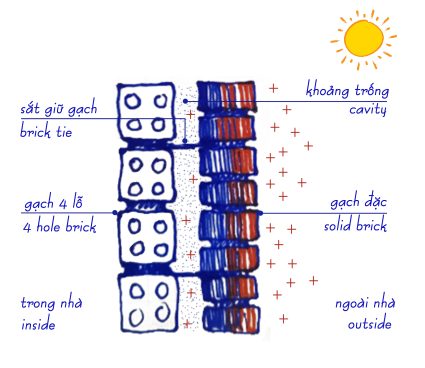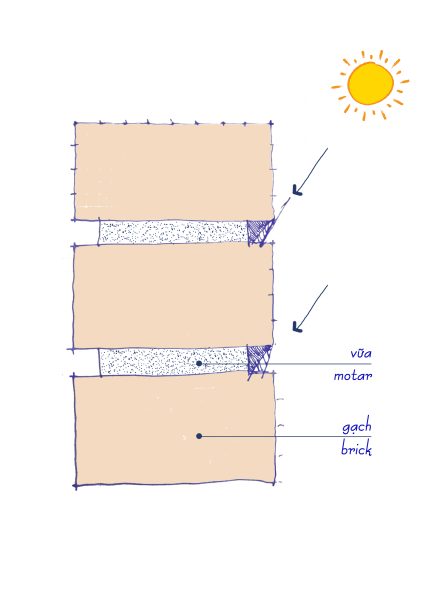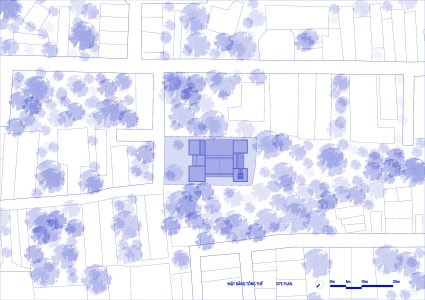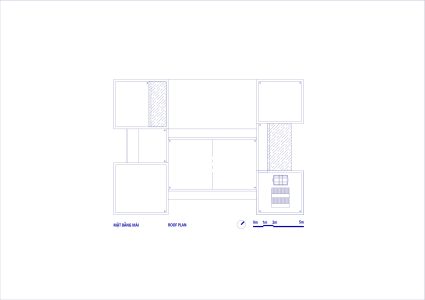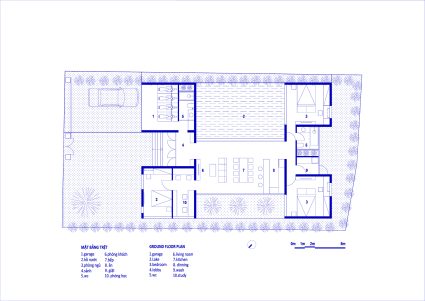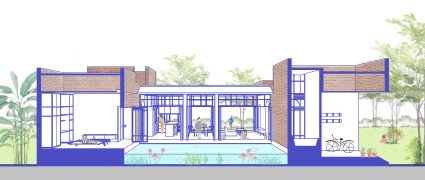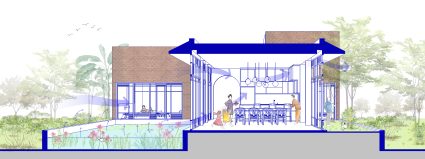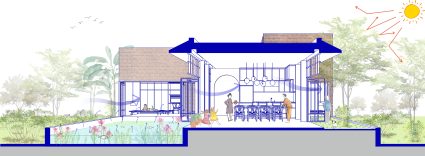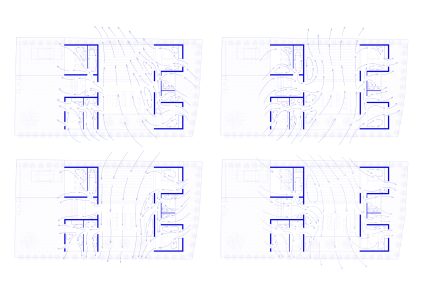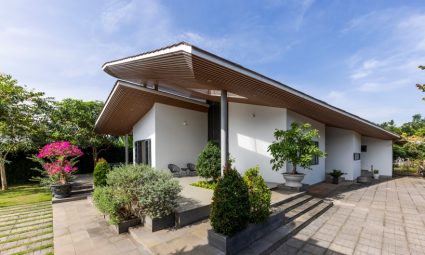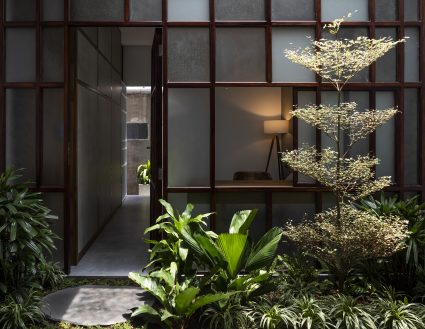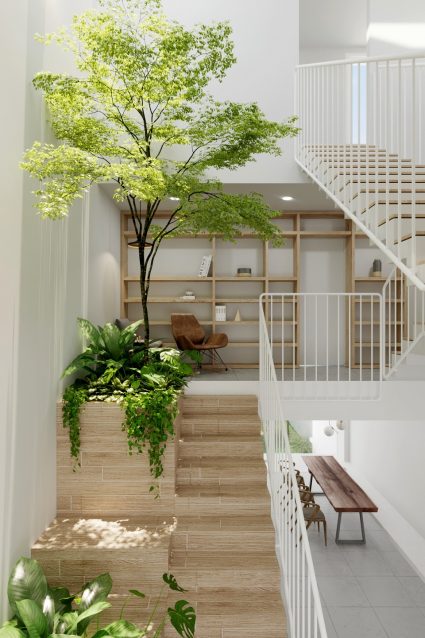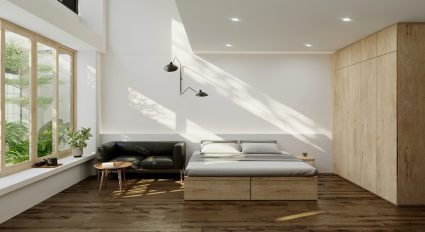NAM HOUSE –TROPICAL MODERN ARCHITECTURE
- CONTEXT:
Position – The building is located in Thu Duc city which situated in HCM city, being one of the biggest cities in Vietnam. According to some science studies recently, the city’s temperature seems to be higher 8-11 degree Celsius in comparison with rural areas with the same climate.
Life – Our daily life cycle is formed by 3 statuses: Working – Exhausting – Healing. In which, healing throughout entertaining, relaxing and sleeping are indispensable to regain balance to our bodies after a whole day of hard-working. But this cycle is usually inhibited by unfavorable climate which leads to mental and physical stress. This stress might be generated by lack of comfort in living accommodation leading to poor efficiency and cause asthenia.
Climate – Earth’s temperature is increasing gradually. As observed, Vietnam has set a record of excessive temperature to 44.1 degree Celsius. In fact, the comfortable environment temperature of our bodies is barely 24-28 Celsius degrees. On top of that, our bodies sweat at 28-32 degree Celsius and get thermal shock above 32 degree Celsius. Surprisingly, under current climatic conditions, the highest record of temperature is broken rapidly every few years past. Additionally, Thu Duc lies in the tropical monsoon climate with many heavy rain and blazing hot days throughout the year.
Therefore, our greatest concerns about designing modern tropical architecture is climate comfort.
- CONCEPT
Nam house is situated in a minor alley, given by their grandparents throughout many generations traditionally, hence their neighborhoods are close relatives. To be more specific, the abutting house belong to the owner’s mother and the other adjoining land area is also the property of their relatives. Thus, the owner’s desire is to connect their home with the surroundings environment, especially their mother’s house beside.
Consequently, the designing process comes to a solution in which the building would be split into 3 distinctive blocks, with 2 soilid blocks at front and back of the house connected by a void block in between.
+ The front block is designed for garage, toilet, entrance, bedroom and study room. Because of the privacy functioning, this block is mainly covered with dense walls.
+ The back block is arranged for 2 bedrooms,bathroom and a laundry area . These are also private spaces so we also decided to surround it with dense walls.
+ The middle block is built for the dining area, this is an open space created to connect with the natural elements and the owner’s mother house. Even though opening both sides of the house induces a large amount of sun light going through, the 2 blocks at both ends appeared as a shelter prevent a part of the sun light effectively.
- BICLIMATIC ARCHITECURAL DESIGN SOLUTIONS::
5 climate control design strategies for achieving thermal comfort in tropical modern architecture.
- Structural insulation
Heat transfer through the house structure can be divided into 3 stages:
+ In phase 1, the exterior of the building receives heat from solar radiation or heat transfer from the surrounding environment.
+ In phase 2, the heat is transferred from the outer surface to the inner surface by conduction.
+ In phase 3, the heat is transferred from the inner surface to the indoor spaces in the form of convection and heat radiation.
The wall layers separation solution aims to prevent heat transfer through the structural surface. The outer shell of the building is protected by a 250mm thick wall, consisting of 3 layers:
+ First layer: a solid brick layer that blocks most of the heat from sunlight. This layer has the advantage of great heat resistance but the disadvantage is the heat retaining for a long period of time.
+ Second layer: the air layer that completely separates the inner wall from the outer wall which is constantly being heated by the sun. Thereby minimizing the heat transfer from the outer wall to the inner wall.
+ Third layer: the inner wall layer built with 4-hole brick walls. Utilizing the 4 hollow holes structure, this can increase the air cushion layer reducing heat transfer (To be specific, heat appears because the air layer is heated due to close contact with the outer wall layer although the air helps prevent heat transfer. But the air itself contact with the outer wall layer continuously heated by the sunlight, the air is also heated up. Nevetheless, the amount of heat transferred is much less than the phenomenon of direct heat conduction).
Passing through three layers of structure, the heat from the sun has been entirely blocked. Simultaneously, the outer wall only have 80mm of thickness can release heat very briskly when the sun goes down.
- Minimizing solar heat gain:
The outer wall surface is the place that receives the most direct sunlight in all the house. In order to lessen the amount of heat shine through the house, we need to reduce this surface area.
The heat offload solution is using raked motar joint: The outer walls is built with bricks have size 40 x 80 x 180, these bricks are connected by a 10mm thick mortar layer. This mortar layer is built 10mm below the surface. By using this building technique, with various sun angles, it creates a shadow area on the wall surface, the area of this mortar layer accounts for 20% of the total wall surface. This built-in joint can help the wall be shaded from 70-80% effectively. Sometime small changes can create a big breakthrough, this detail helped the wall to decrease 14-16% of the heat directly radiated the walls.
- Enhance natural ventilation:
Windows and usage habits: Once-daily, people are often slothful to open windows, mainly because they often forget to close the windows, and sometimes it is the security issues that most people concern about. Therefore, although the house has many windows, they are shut all day long. In these situations, the windows only play a role in natural illumination and utterly invalid ventilation. Therefore, the natural ventilation system in the house is practically paralyzed.
Furthermore, the house is constantly heated by the ambient temperature, combined with the greenhouse effect, the heat accumulation of walls, floors, roofs, etc. This process rises the temperature in the house constantly, heat up the air. Since the natural ventilation system is incapacitate, this generates the hot air that cannot escape at the corner of the house. This process occurs ceaselessly from 8am to 5pm, causing the heat gap between the ambient temperature and the house rise up to 8-15 Celsius degrees.
So as to cool the air temperature, the ventilation has to be available for 24/7, it becomes an independent system separate from human’s activation.
In order to completely solve this problem, all door systems including windows and doors are integrated with Z-shape shades. This shade will be arranged at 2 positions: low part to draw in cold air, high place to release hot air. In addition, each space is arranged with at least 2 windows (except for the walking doors) to refresh the air flw throughout the house easily.
Ventilation and greenhouse effect: According to scientific research, the cause of the greenhouse effect is the transmission of solar radiation heat into the room and the prevention of heat transfer from the room to the outside by convection. In point of fact, in any house situation, even though it has full glass structures, if the doors are opened for ventilation and convection, there will be no greenhouse effect.
Therefore, we would apply this ventilated principle into the common area which is practically covered with glass in order to satisfy the idea of creating a common space connecting to natural elements and the neighborhood. Using such a large amount of glass, with a view to prevent the greenhouse, all doors are designed with a Z-shape shades system for the purpose of air convection 24/7, eliminating the greenhouse effect for this space.
- How to control the heat delay in hot season
In order to ensure that the time when the internal surface temperature of the structure (roof and wall) reach its peak during the day does not coincide with the activity time of the owner, depending on the characteristics of human activities in different functional spaces. In the case of Nam House, the phase delay of heat flow is applied to increase the climate comfort for people as follow:
- 1st Area: including the living room, kitchen and common living space, this space is utilized almost all day long until 9-10pm. With such a continuous usage, this space is situated in the area with the slowest phase.
The amount of heat from the sun’s radiation in the east-west direction must pass through the outer layer, to the bedroom space, the inner wall, the study space, the secondary inner wall before it begins to affect the 1st area. Through many layers of walls and consecutive layers of space like that. The delay of heat radiation makes the amount of direct heat from the sun’s radiation almost disappear.
- 2nd Area: This phase is quite similar to the 1st solar radiation must pass through a series of walls before reaching the bedroom and then the common space. Thereby, the delay of heat flow has almost eliminated most of the effects of solar radiation.
- 3rd Area: bedroom number 3, this area is used from 9pm to 8am. Located in the south direction, the impact of heat radiation is mostly on the two corners of the wall. The head of the bed is arranged against the south wall, so it will not receive direct solar radiation. Therefore, although there is only 1 wall structure to slower the heat phase, the wall area receiving heat does not have direct contact with the bed (the crucial using area).
Thanks to that, the heat flow delay has also eliminated most of the heat that directly affects the bed. With the small amount of remaining heat and the time of use being delayed compared to the heating time of solar radiation, this bedroom also meets the climate comfort. By reason of the utilizing time and the peak heat time is contrasting and only a small amount of heat is backlogging, the bedroom can basically afford the climate comfort.
- 4th Area: Bedroom number 2 is located diagonally to the West of the house, the sun’s impact time is from 12pm to 5pm, this period has a fairly short delay. The using time of the owner is around 9pm to 10am, which is only 4 hours apart. This time period is quite tight for the amount of heat from solar radiation to escape. Thus, the solution is turning the bed away from the area affected by solar radiation.
Thereby increasing the delay of heat flow affecting the bed head, reducing the temperature affecting this area. In addition, the delay of heat flow is also handled in the structural system of the outer wall, this issue has been analyzed in section 1-structural insulation.
- 5th Area: Master bedroom, this area is located in the east direction, although the bed head is set up against the outside wall, since it is located in the east direction, solar radiation only affects this area from 8am – 12pm while the usage time is from 9pm – 8am.
Considering a 9 hours heat-delay phase, it would be enough for the heat to be eliminated without directly affecting the user. In addition, the wall system at the bed head has also been built to delay the heat flow through the structure, thereby this space has also met the climate comfort for the user.
- Use of water plants
In fact, the temperature in green areas can be 6 to 8 °C lower than the temperature in built-up areas.
The lake is located in the Northeast direction to increase humidity and decline the surrounding temperature through evaporation, whereby regulating the climate around the house to become a comfortable zone.
The combination of five design strategies has eliminated most of the environmental climate discomfort problems, thereby establishing a comfortable microclimate area that contributes to improving the quality of life and reducing stress for the homeowner. This is the result that a tropical modern architecture house towards.

